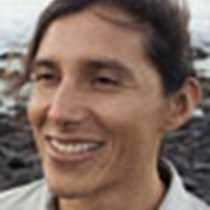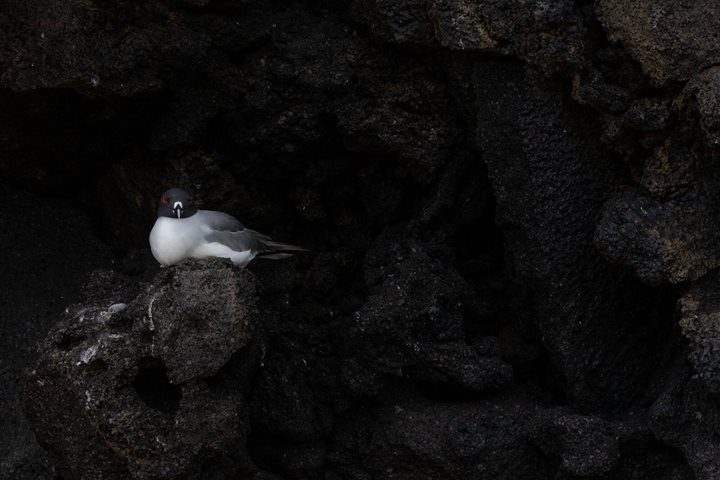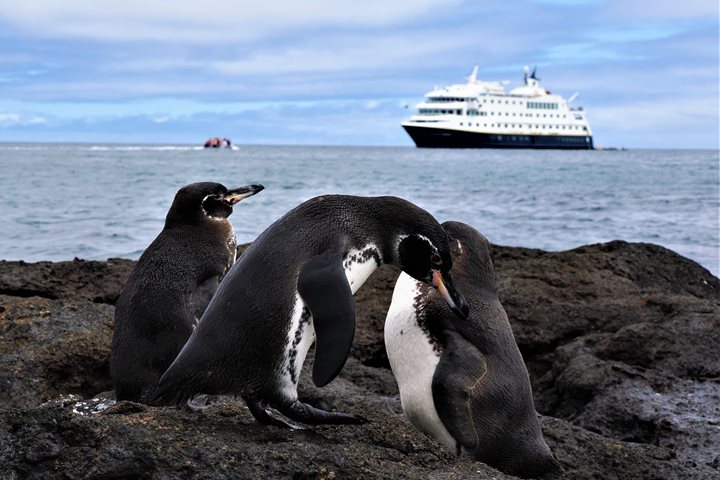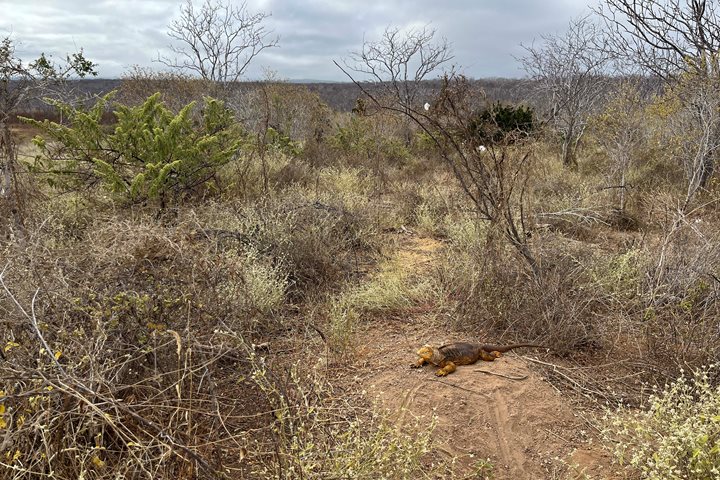Today we woke up at Darwin´s Bay in Genovesa Island. This island is a collapsed volcano and is the northernmost island of the archipelago that we visited during this expedition. Photographers had an early visit to Darwin´s beach where they took advantage of the morning light to practice their photography skills and learn more tips with the experts onboard. After breakfast, guests disembarked for a natural history adventure. This visit offered a unique opportunity to see many species of sea birds, including the exotic red-footed boobies, two species of frigate birds, Nazca boobies, short-eared owls and swallow-tailed gulls and a few species of Darwin’s finches. After lunch, some guests had their last snorkeling and paddle boarding sessions of the trip, while the young explorers enjoyed learning Zodiac lessons around the calm waters of the bay. The day finished with a natural history walk at Prince Phillip`s steps in search of the short-eared owl that inhabit this area of the island, hunting for storm petrels. During this visit, we could also observe the fur seal, the second species of sea lion that we found in this trip. After this walk, we went back for a farewell cocktail on board to celebrate our exciting week in Galapagos.
- Daily Expedition Reports
- 08 Jun 2018
Genovesa Island, 6/8/2018, National Geographic Endeavour II
- Aboard the National Geographic Endeavour II
- Galápagos
Javier Carrion, Naturalist
Javier grew up on Santa Cruz island where his grandparents first arrived in the 1940´s. Veritable pioneers, his grandparents settled in the highlands where they found a place to raise their children.
Read MoreShare Report
Galápagos Aboard National Geographic Endeavour II
VIEW ITINERARYRelated Reports
10/6/2022
Read
National Geographic Endeavour II
Bartolome Island & Sombrero Chino
On National Geographic Endeavour II today, we explored Bartolome, home of a small colony of Galapagos penguins. Bartolome is one of the youngest islands, and it is located next to Santiago Island in the central part of the archipelago. After an amazing sunrise, we went ashore for a walk, and we were transported back to a time when the land was newly formed. We began our day by hiking to the top of a tuff cone known as the islet of Bartolome, named after the First Officer of The Beagle . Walking on this young island allowed us to understand the formation and volcanism of the Galapagos Islands. The rocks are a great way to understand the area and its geology. We spotted a few lava lizards and painted locusts, some of the very few animals on this island. As we reached the top, we had a great view. Our guests enjoyed the magnificence of Pinnacle Rock. After we visited one of the most iconic geological formations of the Galapagos, our breakfast was enhanced by dramatic views of the impressive volcanic landscape. We visited the beach near Pinnacle Rock, where we enjoyed how the sun made the sand sparkle due to a concentration of silica. Later, we went snorkeling along the channel between Santiago and Bartolome Islands. Many of our guests spotted whitetip reef sharks and very colorful parrotfish. The landscape was beautiful with lots of sea stars. We enjoyed the chance to be surrounded by Galapagos penguins and feel accepted as part of this environment. After a delicious Mexican lunch, we had lectures on the photography of reptiles and Darwin. Afterwards, we went to Chinese Hat Islet to snorkel from the Zodiacs. The area is home to a small colony of Galapagos penguins. In a sandy-bottomed, sheltered channel, our guests enjoyed swimming with whitetip reef sharks, rays, and many fish. It was a nice and sunny afternoon. After snorkeling, we had the chance to explore the unique, small volcano that formed an island in front of Santiago on a sunset Zodiac ride. After a spectacular day full of activities in the field, we returned on board. Every day in the Galapagos is an opportunity to reconnect with the beauty of nature through unbelievable encounters!
10/5/2022
Read
National Geographic Endeavour II
Cerro Dragón, Santa Cruz Island
Today, National Geographic Endeavour II visited Cerro Dragon, located on the north part of Santa Cruz Island. We found one of the largest colonies of land iguanas. During our hike, we spotted the iguanas all around the trail. Some basked on the vegetation, and others were active. We saw the zigzag head movement they use to protect their territory and impress females. An Ecuadorian buffet lunch was set up in the dining room. We started with the traditional ceviche and ended with tres leches for dessert! We enjoyed snorkeling and Zodiac rides. We observed wildlife all over the place, including spotted eagle rays, sharks, blue-footed boobies, great blue herons, marine iguanas, and hundreds of other animals. They all reminded us why the Galapagos is so special.







